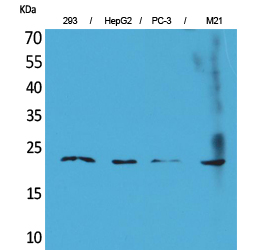产品名称
FGF-6 Rabbit Polyclonal Antibody
别名
FGF6; HST2; HSTF2; Fibroblast growth factor 6; FGF-6; Heparin secretory-transforming protein 2; HST-2; HSTF-2; Heparin-binding growth factor 6; HBGF-6
蛋白名称
Fibroblast growth factor 6
存储缓冲液
Liquid in PBS containing 50% glycerol, 0.5% BSA and 0.02% New type preservative N.
Human Gene Link
http://www.ncbi.nlm.nih.gov/sites/entrez?db=gene&term=2251
Human Swissprot No.
P10767
Human Swissprot Link
http://www.uniprot.org/uniprotkb/P10767/entry
Mouse Gene Link
http://www.ncbi.nlm.nih.gov/sites/entrez?db=gene&term=14177
Mouse Swissprot No.
P21658
Mouse Swissprot Link
http://www.uniprot.org/uniprot/P21658
免疫原
The antiserum was produced against synthesized peptide derived from the C-terminal region of human FGF6. AA range:159-208
特异性
FGF-6 Polyclonal Antibody detects endogenous levels of FGF-6 protein.
稀释度
WB 1:500 - 1:2000. ELISA: 1:20000. Not yet tested in other applications.
宿主
Polyclonal, Rabbit,IgG
背景介绍
The protein encoded by this gene is a member of the fibroblast growth factor (FGF) family. FGF family members possess broad mitogenic and cell survival activities, and are involved in a variety of biological processes, including embryonic development, cell growth, morphogenesis, tissue repair, tumor growth and invasion. This gene displayed oncogenic transforming activity when transfected into mammalian cells. The mouse homolog of this gene exhibits a restricted expression profile predominantly in the myogenic lineage, which suggested a role in muscle regeneration or differentiation. [provided by RefSeq, Jul 2008],
组织表达
Leukemia cell lines with platelet/ megakaryocytic differentiation potential.
细胞定位
Secreted, extracellular space.
信号通路
MAPK_ERK_Growth;MAPK_G_Protein;Regulates Actin and Cytoskeleton;Pathways in cancer;Melanoma;
功能
function:Can transform NIH 3T3 cells. Exhibits strong mitogenic and angiogenic properties.,similarity:Belongs to the heparin-binding growth factors family.,tissue specificity:Leukemia cell lines with platelet/ megakaryocytic differentiation potential.,
纯化
The antibody was affinity-purified from rabbit antiserum by affinity-chromatography using epitope-specific immunogen.


